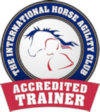What is an ATI or ETI?
What is an ATI or ETI?
This is an article I wrote as part of one of my assignments for the NAC diploma in equine training and coaching. Whilst it is from the point of view of explaining the role to someone who is interested in becoming an ATI/ETI, it is still useful to highlight what an ATI/ETI does.
Lets first look at what an E.T.I (equine training instructor) is and what the role involves with regards to Coaching, working with Paraprofessionals and various legislation.
An E.T.I coaches people in how to train new behaviours in their horses. This means that they have to be able to use various coaching methods to suit different learning styles, to be able to deliver the material in the best possible way for the client to understand and learn. This may include showing the client how to carry out an exercise or describing it and then having the client attempt it with suggestions made after the attempt at how to improve it. The instructor needs to remember to always mention the positives too. They have to be able to clearly communicate their ideas and instructions to their clients. This includes connecting with the client on an emotional level and actively listening to what the client has to say. Even something as simple as starting a session with “how are you today” can give a valuable insight into the clients frame of mind and allow you to tailor a session appropriately for their capability at that time.
Professionalism- keep learning, cpd (continued professional development), be the best you can be at any time. Encourage all clients to meet the highest standards of equine welfare. Give advice and support where you feel improvements could be made and refer participants to an equine professional should you feel that this would be of benefit to the client and horse, such as mentioning that you are not sure the saddle is of the best fit and they should discuss this with their qualified saddle fitter.
Keep all client records secure, don't discuss clients with anyone else. Maintaining privacy of clients consultations and training.
As far as health and safety is concerned, check ppe (such as hard hats and back protectors) is up to standard, check tack is well fitting and correct for the scheduled activity. Suggest that gloves and appropriate footwear should be worn, it may be worth including in this, the sort of footwear that isn't considered to be appropriate. Complete risk assessments for all venue/horse/clients prior to a session, these draw your attention to possible hazards and help to keep you all safe and help prevent accidents. Equipment should be used correctly with the welfare and comfort of the horse in mind. Ensure all activities you organise are appropriate for the participants’ ability level, age and maturity, focusing your coaching on the individual and recognising the diversity of an individual’s needs. Ensure you have adequate insurance, such as professional indemnity and public liability,
Only provide advice in the areas you are qualified to do so and know when to signpost others to equine and human medical professionals. Work within capabilities, a C.A.B (clinical animal behaviourist) may pass on a case to an E.T.I once they have addressed the underlying behavioural problem so that the E.T.I can then assist with training new behaviours.
Ensure that any advice given is current and valid at the time, to ensure it meets best practice.
.png)



